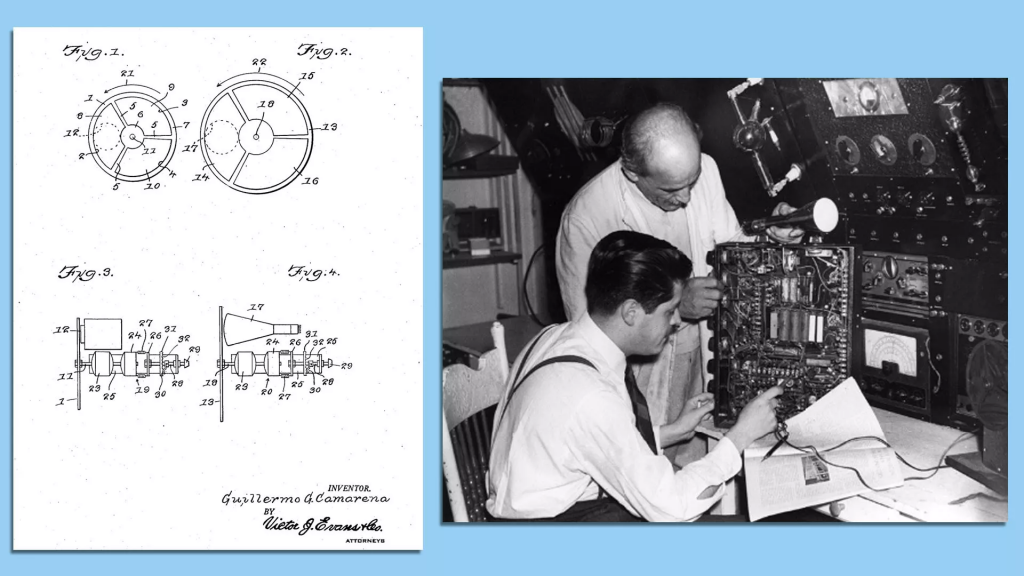6 Guillermo González Camarena: Inventor of the Color TV
KC Celestine

[The Flesch-Kincaid Grade Level is: 11.2 due to technical terminology]
Guillermo González Camarena was born on February 17, 1917 in Guadalajara, Jalisco, Mexico. He was the youngest of seven siblings. His parents were Arturo González and Sara Camarena. As a kid he enjoyed building electric toys. He even had a laboratory in the basement of his house where he could build them. He built his first amateur transmitter at age 12. While he experimented in his laboratory, he also worked at the radio station of the Ministry of Education. At the age of 17, he built his own television camera. He later became an electrical engineer who specialized in electronics at the National Polytechnic Institute of Mexico.
González Camarena developed the first Trichromatic Field Sequential System, the technology that transmits moving images in variations of red, green and blue to achieve a spectrum of color. In 1940, at 23-year-old he patented a chromoscopic adapter for television equipment. This allowed black and white cameras of the day to capture color. Prior to his invention, televisions only broadcast images in monochrome. This was the first patent in the world for color TV. NASA used this as recently as 1979 to transmit images from Jupiter.

González Camarena’s curiosity also led him into the field of astronomy. He manufactured his own telescope, which earned him the job as head of the Astronomical Association of Mexico. In 1941, he was appointed chief operator of radio stations XEQ and XEW. In 1950, the Columbia College of Chicago asked him to design a television system. He exported them televisions produced in Mexico. In that same year, Columbia College awarded him an honorary degree of Professor Honoris Causa. In September 1954, Columbia College’s Los Angeles campus awarded him the title of Doctor Honoris Causa.
He also championed tele-education for medical school, as well as the use of TVs for transmitting educational shows to Mexicans in remote, school-less locations.
In 1951, González Camarena married María Antonieta Becerra Acosta, whom he met at XEW. They had two sons, Guillermo and José Arturo.
His contributions helped modernize how we could see the world today. He died in a car accident in Puebla, Mexico on April 18, 1965 when returning from inspecting the television transmission station of Channel 5 in Las Lajas, Veracruz. He was 48 years old.
In 1970, the 18th of April was instituted as the Day of the Television Technician in memory of González Camarena. In 1995, a multidisciplinary group concerned with scientific and technological research in Mexico founded the Guillermo González Camarena Foundation, which seeks to promote the talent and creativity of national inventors.
Guillermo González Camarena is referenced in the video at 1:32-2:34
Writing Prompts
Narrative: When Guillermo González Camarena was a kid he spent his free time in his laboratory creating new toys and inventions. Write a brief story about something fun you did during your free time. CCSS.ELA-LITERACY.W.6.3
Informative: Tele-education or remote learning is something many people have experiences recently. Explain in your own words how technology is used during remote learning. CCSS.ELA-LITERACY.WHST.6-8.2
Persuasive: While current movies and shows are in color, black and white movies and television shows can still be found on some channels. Argue for which you think is better or more pleasing to watch. Please cite any sources you use. CCSS.ELA-LITERACY.WHST.6-8.1
Creation/Application:
Creating your own telescope is easy to do with the right tools. Follow these instructions to make your own telescope. The two convex lenses can even be lenses from old reading glasses. Once complete, test out your new telescope.
Works Cited
Carrillo, Karen Juanita. “7 Groundbreaking Inventions by Latino Innovators: From entertainment devices to lifesaving medical technologies, Latino inventors have advanced humankind through their contributions.” History.com, 15 Oct 2021, www.history.com/news/latino-hispanic-inventions. Accessed 6 July 2022.
The Exploring Mexico Editorial Team. “Guillermo González Camarena.” Explorando Mexico, http://www.explorandomexico.com/about-mexico/5/135. Accessed 6 July 2022.
Franco, Marina E. “Hispanic Heritage Month: Gracias, México, for color TVs.” AXIOS, 21 Sep. 2021, www.axios.com/2021/09/21/mexico-engineering-color-tv-ozone-climate-contraception. Accessed 6 July 2022.
“Guillermo Gonzales Camarena.” Early Color Television, 2017, https://www.earlytelevision.org/camarena.html#:~:text=1970%3A%20The%2018th%20of%20April,is%20founded%20in%20his%20honor. Accessed 6 July 2022.
“Guillermo González Camarena.” Wikipedia, 16, Jun 2022, en.wikipedia.org/wiki/Guillermo_González_Camarena. Accessed 6 July 2022.
“Mexican engineer Guillermo González Camarena was color TV inventor.” Mexican Daily Post, 22 Sep. 2021, www.mexicodailypost.com/2021/09/22/mexican-engineer-guillermo-gonzalez-camarena-was-color-tv-inventor. Accessed 6 July 2022.
a set of equipment used to generate and transmit electromagnetic waves carrying messages or signals, especially those of radio or television
combining colored images so as to produce a picture in natural colors
(of a photograph or picture, or a television screen) consisting of or displaying images in black and white or in only one color
an education in which the students receive instruction over the Internet, from a video, etc., instead of going to school

